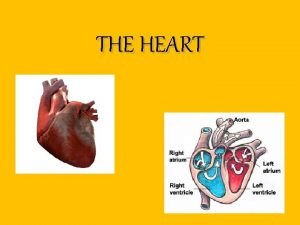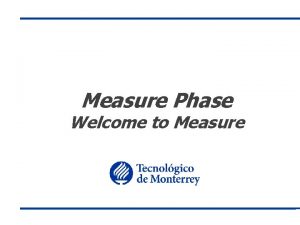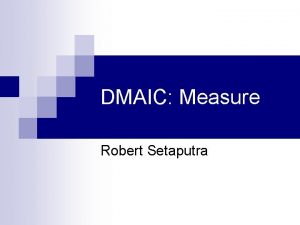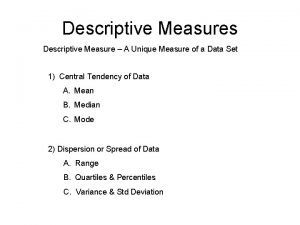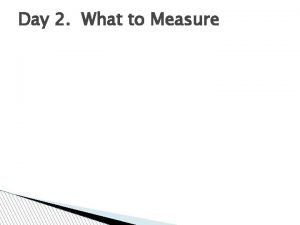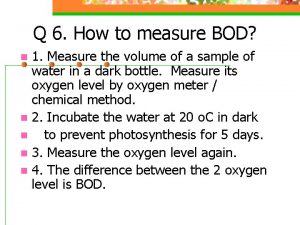Chapter 17 Measure Up How to Measure Your






- Slides: 6

Chapter 17: Measure Up! How to Measure Your Results “Give, and it will be given to you. Good measure, pressed down, shaken together, running over, will be put into your lap. For with the measure you use it will be measured back to you. Luke 6: 38

Introduction Many students have a difficult time figuring out how they will collect their experiment data. Following are some ideas to help you decide how you will quantify the change you are trying to measure. This is only a partial list. Many other devices are available. Whenever possible, use the metric system.

Examples of How to Measure Data Air Pressure Gauge - Used for measuring air pressure. The standard in the United States is the PSI (pounds per square inch) gauge. Brix meter - measures the amount of sugar in clear solutions. Calorimeter - Used for measuring heat flow (the change of temperature). You can make a device with basic materials. Counting - Used for gathering data related to frequency. For example, counting the number of cars that pass a certain point in a given amount of time. Decimeter - Used for measuring the intensity of a sound in decibels. Electroscope/Electrometer - Used for measuring electric charge. You can make this device from basic materials (wire, glass jar, cardboard, and paper). Time will be needed to make your device accurate. Hydrometer or Measuring Cup - Used for measuring the volume of liquids. Some measuring cups can measure liquids in milliliters. Microscope and counting - Used for quantifying matter that is very small. Often used with a glass slide that contains a grid for easier estimation. Multimeter - Used for measuring electrical volts and amperage. You may be able to borrow one from an electrician or purchase one at a hardware store. Photo Scanner and Photoshop (Adobe, GIMP, NIH Image) Used for measuring and analyzing light. Protractor - Used for measuring angles in degrees. Ruler or Tape Measure - Used for measuring distances. Be as accurate as possible (for example: 2. 3 cm or 23 mm). Scale - Used for measuring weight (force of Earth's gravity on objects). Be as accurate as possible (for example: 58. 2 g). Stop Watch - Used for measuring time. Many digital watches and cell phones have this feature. Thermometer - Used for measuring the amount of heat. Use the Celsius scale and the most accurate thermometer you can find.

Data Created Through Calculations Acceleration - Finding the change in speed is not that difficult to calculate once you have several speed measurements at distance intervals. Density - Calculate the weight per given volume to find the density of the object. Speed - All you need is distance and time measurements to find speed. Volume of Solids - Calculate the resulting volumes of solids. You can also do this by the displacement method.

Finding the right number There are so many different ways to measure things. The measurement depends on what is being measured. There are measurements of time, length, temperature, loudness of sound, brightness of light, amounts of pressure, weight, and p. H just to name a few. In order to help you determine how to measure your outcome appropriately, work on the following questions. g? n i t s e t e ar u o y e l b ria a v t n e What is the o d n e p e d utcome you a n i e h t s i t re expecting? What do you need to detect? ol? What tool do o t is h t e s u u o you need to How do y detect this m easurement?

Based on your answers to the questions on the previous slide, determine how you are going to measure your outcome. What tools do you need to do your measuring? What data do you need to collect? How will you do it? Record all of these ideas in your journal. Remember to write all of this in your scientific notebook!!





